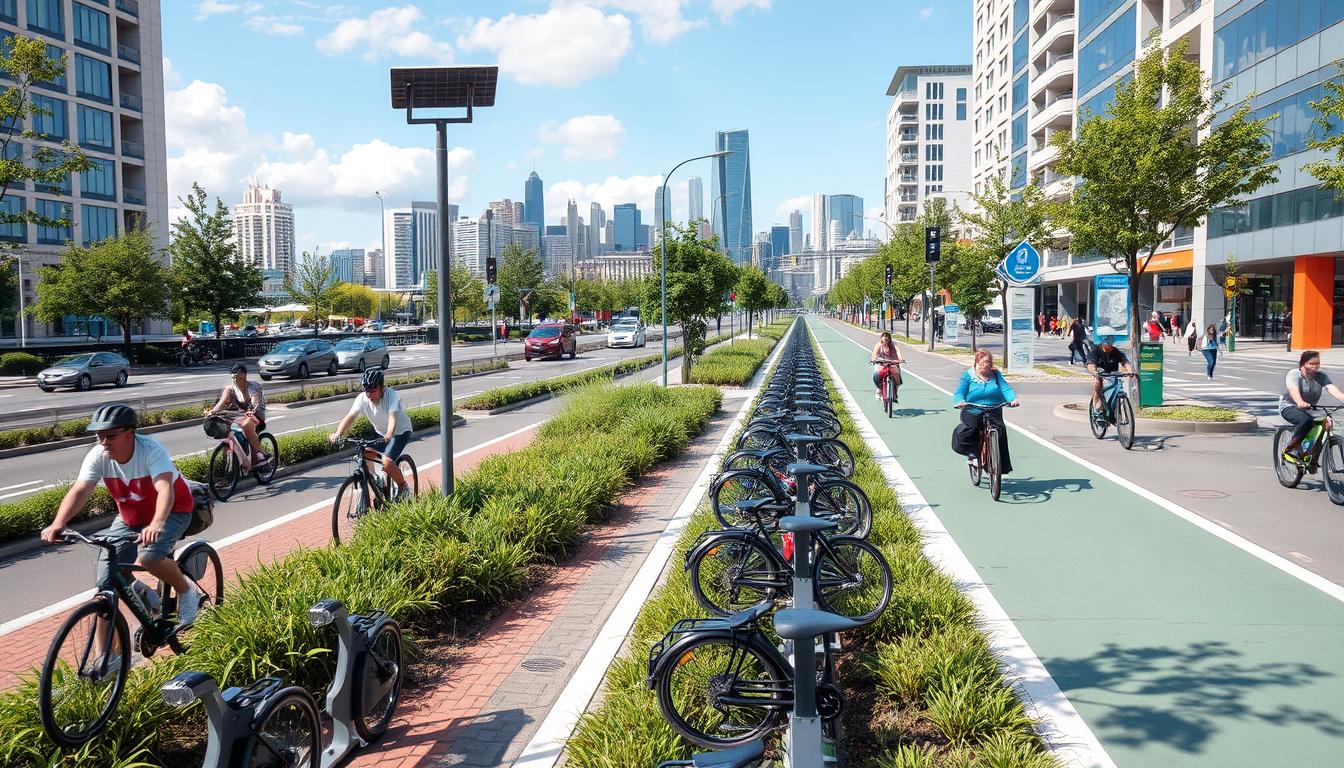Transportation is changing fast, with a focus on making it greener. By embracing a Sustainable Commuting Guide, the average person—who emits a significant amount of carbon dioxide each year—can discover new green ways to travel that dramatically reduce emissions.
This guide looks at the latest in eco-friendly travel. It shows how to save money and protect the planet. More and more companies are making green travel a big part of their plans for 2025.
People want to support brands that care about the environment. Choosing green transport is not just good for the planet. Also, innovative money companies can see a significant return on their investment in just three years.
We’ll cover 12 new ways to travel that are good for the planet and your wallet. From electric cars to new mobility services, we’ll guide you through the future of green travel.
If you want to reduce your carbon footprint or your company wants to go green, this guide is for you. It offers the knowledge you need to make choices that matter.
Understanding the Environmental Impact of Daily Commuting
Daily commuting is a big contributor to global carbon emissions. The transportation sector is key for reducing carbon footprints. Knowing how our travel choices affect the environment helps us make greener choices.
Global Transportation Emissions Overview
Transportation significantly contributes to global greenhouse gas emissions, which drive climate change. Vehicles, aeroplanes, and ships release substantial carbon dioxide and pollutants, underscoring the urgent need for sustainable alternatives.
Here are some interesting facts about carbon emissions from different transport modes:
- Conventional gasoline cars emit between 110-230 gCO2e per passenger-kilometer.
- Electric vehicles can reduce emissions to as low as 65 gCO2e per passenger kilometre.
- Bicycles remain the most environmentally friendly option at just 5 gCO2e per passenger kilometre.
Carbon Footprint Comparison of Transportation Methods:
| Transportation Mode | Carbon Emissions (gCO2e/pkm) |
| Conventional Bicycle | 5 |
| Electric Scooter | 45-75 |
| Electric Bus | 40-80 |
| Gasoline Car | 110-230 |
Urban Mobility Challenges
Cities worldwide face considerable challenges in cutting down transportation emissions. Innovative solutions like electric bikes and better public transit can help a lot. For example, if electric bike trips made up 11% of vehicle trips, emissions could drop by about 7%. Urban mobility expert,
Every sustainable commuting choice contributes to a greener future.
The Economic Benefits of Green Transportation
Eco-friendly transportation is changing the game for businesses and people. It brings big financial wins that go beyond just helping the planet. Companies that go green can find significant economic gains. Electric vehicles (EVs) are a great example.
Sustainable Commuting Economic Advantages
They are super efficient and save money:
- EVs turn over 77% of electrical energy into power for moving.
- Federal tax credits up to $7,500 for buying EVs.
- They can cut fleet costs by up to $750 per 15,000 miles.
Green Business Research Institute,
Sustainable transportation isn’t just an environmental choice—it’s a smart financial strategy.
The perks of green commuting reach far and wide:
| Transportation Type | Cost Savings | Emission Reduction |
| Electric Vehicles | Up to 80% less maintenance costs | 26-90% less greenhouse gas emissions. |
| Public Transit | Less money spent on getting around | 45% less CO2 emissions than driving alone. |
| Bicycles/E-Bikes | No fuel costs | 100% less emissions from travel. |
Businesses that choose green transport get more than just cost savings. They see better employee work, a stronger brand image, and more green-conscious customers. With 66% of shoppers ready to pay more for eco-friendly brands, green transport is a smart money move.
Electric Vehicles as Sustainable Commuting Solutions
Green travel is changing city travel with electric vehicles (EVs). EVs offer a key way to make commuting more eco-friendly. The transport sector needs to reduce carbon emissions, and EVs greatly help those who care about the planet.
Electric Vehicle Charging Station
Today’s electric vehicles are a big step forward in green travel technology. They perform well and are suitable for the environment. Drivers can now choose from advanced EVs that address old worries about range and charging.
Latest EV Technology Advancements:
- Improved battery technology extending the driving range.
- Faster charging capabilities.
- Enhanced energy efficiency.
- Reduced battery production costs.
Charging Infrastructure Development
More charging spots are key to making EVs practical for daily trips. Governments and companies are investing in more stations in cities and rural areas.
EV Charging Network Expansion:
| EV Charging Network Expansion | 2022 | 2025 Projection |
| Public Charging Stations | 50,000 | 120,000 |
| Fast-Charging Locations | 6,500 | 15,000 |
Cost-Benefit Analysis of EV Ownership
Electric vehicles are a wise financial choice in the long run. The total cost of ownership keeps decreasing as tech improves and the government helps make EVs more affordable.
Electric vehicles convert over 77% of electrical energy to power at the wheels, compared to only 12%–30% for gasoline vehicles.
Choosing electric vehicles means lower upkeep costs, cheaper fuel, and tax breaks. Switching to EVs is wise for your wallet and the planet.
Public Transit Systems: The Backbone of Sustainable Commuting Guide
Public transit is key to making cities more sustainable. Intelligent Transport Systems (ITS) are changing how cities move people. They make public transport more innovative and more efficient.
Public Transit Sustainable Commuting
Urban mobility expert,
Sustainable transportation is not just about moving people, but moving them smartly and efficiently.
Cities are adopting innovative strategies to reduce pollution and improve mobility through green transportation and pedestrian-friendly spaces, enhancing urban livability and sustainability.
They focus on:
- Real-time tracking technologies.
- Integrated payment systems.
- Dedicated transit lanes.
- Connecting different ways to travel.
Good public transit brings big wins for both the planet and the wallet. Studies show public transport can cut environmental impact by up to 45%. Cities with strong transit systems see a 30% drop in traffic jams.
New tech is making public transit better. Automatic tracking, bright traffic signals, and information for travellers make trips easier and greener.
Public Transit Performance Metrics:
- Shorter waits.
- More reliable schedules.
- Better access.
- Less pollution.
The guide stresses that good public transit is more than just roads and buses. It’s about creating a system that’s easy to use, affordable, and good for the planet.
Bicycle Infrastructure and Active Transportation
Bike commuting is a big step towards making cities greener. Cities are now seeing how bike paths can make communities better and healthier.
Urban Bicycle Infrastructure
How we move around cities is changing, thanks to bikes. Bikes help cut down on pollution and make life better for everyone. Adding bike-friendly roads and paths is key to a greener future.
Urban Bike Lane Networks
Bike lanes are transforming our travel experience, making it safer and more efficient. As more people embrace cycling, cities are becoming greener and less congested.
Here are some crucial points:
- 45% of U.S. residents would use public transport if it had bike access.
- Cities with sound bike systems see 25% more people biking to work.
- Less traffic in cities means smoother rides for everyone.
Bike-Sharing Programs
Bike-sharing is a big win for the environment. Here’s why:
| Metric | Performance |
| Transit Ridership Increase | 30% |
| Annual Bike-Sharing Revenue | $1.5 Million |
| Commuting Cost Reduction | 25% |
Safety Considerations for Cyclists
Keeping cyclists safe is a top priority. Here’s how:
- Better bike lanes.
- More bike safety classes.
- Laws that protect cyclists.
Urban planning expert,
Bicycles are a key solution to creating more livable, sustainable urban environments.
By focusing on bike paths, cities can make a big difference. They can make cities healthier, reduce environmental harm, and change how we move around.
Carpooling and Ride-Sharing Innovations
Carpooling is changing how we move around cities. It helps cut down on pollution and traffic jams. The ride-sharing market is growing fast and is expected to jump from USD 85.8 billion in 2021 to USD 185.1 billion by 2026.
Carpooling Innovations In Green Travel
Transportation Innovation Research Group,
Shared mobility represents the future of green travel, connecting communities while reducing environmental impact.
New tech is making carpooling better. It’s now more straightforward for people to find and share rides.
The main changes include:
- Innovative mobile apps that pair drivers and riders.
- Algorithms that optimize routes in real-time.
- Systems for easy payments.
- Technologies to check safety.
Carpooling brings significant benefits for both our wallets and the planet. Big names like Uber and Lyft are making a big splash in the market.
Here is a comparison table:
| Company | Pooled Rides Percentage (2017) | Market Impact |
| Uber | 20% | Global presence. |
| Lyft | 40% | Strong North American market. |
Carpooling is more than just a way to get around—it’s about creating sustainable, connected communities. As cities grow, ride-sharing will be key to making them better and greener.
Walking and Micro-Mobility Options
Urban transportation is changing fast. Walkable communities and eco-friendly transport are key to solving today’s mobility problems. The focus is on sustainable, compact, and efficient mobility in cities.
Micro-Mobility Urban Transportation
Pedestrian-Friendly Urban Planning
Cities are being thoughtfully redesigned to become more walkable, with vibrant sidewalks, green spaces, and pedestrian-friendly amenities that encourage residents and visitors alike to explore their surroundings on foot.
Now, urban planning focuses on:
- Wide, accessible sidewalks.
- Traffic calming measures.
- Mixed-use development zones.
- Connected pedestrian networks.
E-scooters and Personal Mobility Devices
Micro-mobility is changing how we travel short distances. Electric scooters and personal mobility devices are green alternatives. They cut down on carbon emissions and reduce city traffic.
Different Options and their Efficiency:
| Micro-Mobility Option | Carbon Reduction | Urban Efficiency |
| E-Scooters | 70% lower emissions | High urban manoeuvrability. |
| Electric Bikes | 65% carbon reduction | Extended travel range. |
| Personal Mobility Devices | 80% fewer emissions | Compact storage. |
Last-Mile Transportation Solutions
Last-mile transport is key to fixing public transit gaps. Integrated micro-mobility options link different transport modes, making travel more efficient and green. Urban Planning Institute,
The future of urban transportation lies in flexible, interconnected mobility solutions that prioritize human and environmental well-being.
The global micro-mobility market is set to hit $300 billion by 2030. These new transport methods are a big step towards greener, more efficient city living.
Digital Tools and Apps for Green Commuting
The digital world is changing how we travel green. The green tech market is set to grow from $28.6 billion in 2024 to $134.9 billion by 2030. Digital tools are key in making our commute more sustainable.
Mobile apps are helping us choose greener ways to travel. They offer features like tracking public transit, planning trips, calculating carbon footprints, etc. These apps make green travel easier.
- Real-time public transit tracking.
- Multimodal trip planning.
- Carbon footprint calculation.
- Bike-sharing and carpooling integrations.
Some apps are leading the way in green commuting:
| App Name | Key Feature | User Rating |
| Klima | Carbon Footprint Measurement | 4.6/5 |
| Scoop | Carpooling Platform | 4.7/5 |
| Bikemap | Global Cycling Routes | 4.3/5 |
Mobility as a Service (MaaS) platforms are changing urban transport. They combine different transport options into one easy experience. This makes green travel more accessible and fun. Transportation innovation expert,
Technology is the key to making sustainable transportation not just possible, but practical and enjoyable.
By 2026, over 50% of companies will use environmental apps. This shows how important digital tools are for green commuting.
Corporate Sustainability Programs and Commuter Benefits
Modern businesses are changing how we get to work with new ideas. They see how getting to work affects work, the planet, and happiness. This is a significant change.
Helping employees get to work is a key part of being a good boss. Companies are finding new ways to save money and protect the environment.
Workplace Transportation Incentives:
- Pre-tax commuter benefits up to $315 monthly.
- Subsidized public transit passes.
- Bike-to-work reimbursement programs.
- Electric vehicle charging station installations.
Remote Work Policies
Working from home is changing how we work. With people spending 26.4 minutes commuting, working from home saves money and reduces pollution. IRS guidelines,
Commuter benefits can allow employees to use pre-tax dollars to cover qualified transportation expenses.
Employee Transit Benefits
Companies with good commuter benefits see big wins:
- 7.4% less carbon emissions.
- Happy employees.
- More diversity and inclusion.
- Money-saving for employers.
Companies care about their workers and the planet by focusing on green commuting. It’s a win-win.
Future Trends in Sustainable Transportation
The world of eco-friendly transportation is changing fast. New technologies and global goals are leading the way. Electric vehicles are leading this change, with 1.36 million sold in 2023. This is the highest number of electric car sales ever. Transportation Innovation Institute,
The future of transportation is green, intelligent, and interconnected.
Green travel trends are changing how we move around cities:
- Autonomous vehicle networks that optimize route efficiency.
- Smart city transportation integration.
- Advanced battery and charging technologies.
- AI-powered transportation management systems.
The electric vehicle market is growing fast, with sales up 40% annually. The number of charging stations has doubled in three years, making electric cars more convenient than ever.
But it’s not just cars. The sea and sky are also getting greener. New technologies are making ships and planes less polluting.
Companies and governments are pushing for more green travel. For example, they offer up to $315 a month for commuting in cities, encouraging people to choose greener ways to get around.
- Reduced carbon emissions.
- Lower transportation costs.
- Improved urban air quality.
As tech improves and we learn more about the environment, green travel will become a big part of our lives. It will help make cities better and more sustainable.
Conclusion
The need for sustainable commuting is urgent. Transportation is a significant source of greenhouse gas emissions, making our choices very important. This guide shows how to change urban mobility with new tech, planning, and personal effort.
We’ve found many ways to make transportation greener. Public transit can cut emissions by up to 45%, and cycling can reduce them by 60% compared to driving. Plus, it saves billions by reducing traffic and boosting productivity.
We need everyone’s cooperation to make sustainable commuting work. Governments, businesses, and individuals must join forces. Electric cars, bike-sharing, remote work, and digital tools can change how we move around.
Our choices can make a big difference. We need to keep innovating, support policies, and get involved. By choosing sustainable transport, we can reduce environmental harm, improve cities, and create a cleaner future. Start your sustainable commute today.
Frequently Ask Questions (FAQ)
What are the most effective ways to reduce my carbon footprint while commuting?
Try using public transit, cycling, or walking to reduce carbon emissions. Carpooling and electric vehicles are also good choices. These options are better than driving alone in a gas-powered car.
How much money can I save by switching to sustainable transportation methods?
By choosing green transport, you could save 0 to 000 a year. This includes less money spent on fuel, car upkeep, parking, and maybe even tax breaks.
Are electric vehicles environmentally friendly?
Electric vehicles (EVs) are much better for the environment than gas cars. They don’t emit direct pollutants, have lower carbon footprints, and get even cleaner as energy sources improve.
What are the best micro-mobility options for short urban trips?
For short trips, e-scooters, bike-sharing, and electric bikes are great. They’re affordable, eco-friendly, and help reduce city traffic.
How can my workplace support sustainable commuting?
Your workplace can help by giving transit subsidies, starting bike-to-work programs, and installing EV charging stations. They can also support flexible work hours and carpooling.
What technology can help me make more sustainable transportation choices?
Apps and digital platforms can be beneficial. These include trip planners, transit trackers, bike-sharing services, carpooling apps, and mobility-as-a-service (MaaS) platforms.
Is cycling safe in urban environments?
Cycling in cities is safer with dedicated bike lanes, better infrastructure, and driver education. Cities are investing in cycling networks and safety programs.
What are the health benefits of active transportation?
Walking and cycling are good for your health. They improve heart health, reduce stress, lower obesity risk, boost mental well-being, and reduce air pollution exposure.
How can I start reducing my transportation carbon footprint?
Begin by checking your current commute, looking into public transit, and considering carpooling or biking. Try working from home when you can and slowly switch to greener transport.
Are there government incentives for using green transportation?
Yes, governments offer incentives like tax credits for EVs, transit pass subsidies, bike commuting rewards, and grants for green transport projects.






















